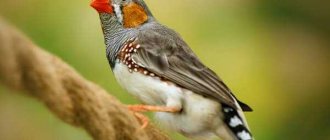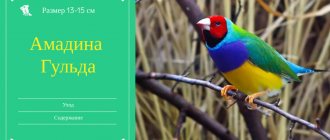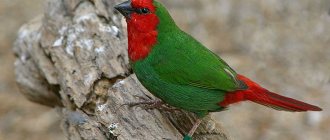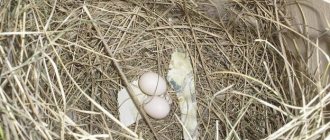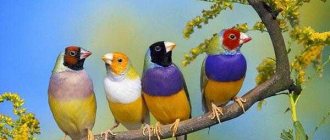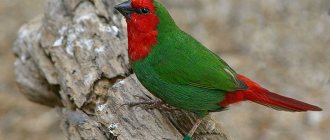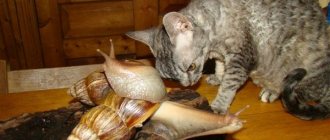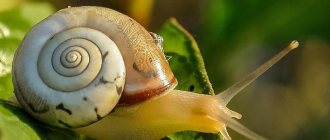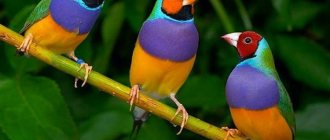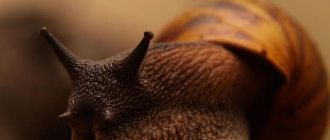Feeding is one of the most important aspects of keeping finches in captivity. The health, life expectancy and successful reproduction of birds depend on the chosen diet. Feeding finches with food that is of poor quality or that is toxic to them can lead to illness or even death of the pets. Feeding finches in captivity should take into account the nutritional needs of these birds. The diet is compiled based on data on the nutrition of finches in nature.
Grain mixtures
The main food for finches is grain mixtures. In nature, the largest portion of the diet of these birds consists of seeds and grains of cultivated and wild plants. This type of food provides birds with energy due to the large amount of carbohydrates it contains, and also acts as a source of vegetable protein, fiber, fats, vitamins, micro and macroelements. Grain mixtures for finches can be prepared independently or purchased ready-made at a pet store.
We assemble it ourselves
Grain mixtures for finches must include at least 6 types of products. The main component of the mixture is millet of various types. Finches eat white, gray and yellow most readily. Red millet should also be included in the bird's diet. It is rich in carotene and carotenoids, which are precursors of vitamin A, which is necessary for healthy eyes, mucous membranes and skin, as well as enhancing the color of feathers.
Peeled oats should be present in the amadin's diet. Birds usually eat it willingly, but in large quantities this food can cause intestinal blockage in them, as it contains a lot of fiber. Flaxseed is of great benefit to birds. It is rich in vegetable fats and fatty acids, which have a beneficial effect on the condition of the skin, feathers and overall health of the bird. Hemp seed also has the same properties, so it is also included in the grain mixture in small quantities. Mandatory components of the grain mixture for finches are also chumiza, rapeseed, mogar and canary seeds.
Finches love the seeds of meadow grasses: hedgehogs, timothy, fescue, shepherd's purse, plantain, etc. They are collected in the summer during the ripening period and dried, and then added to food throughout the year.
Seed collection must be carried out in environmentally friendly places - away from roads, large cities, industrial enterprises and farmland treated with pesticides.
To correctly compose a grain mixture for finches, you should take the following quantities of its components:
- millet – 1 kg;
- canary seeds – 300 g;
- meadow grass seeds – 250 g;
- oats – 150 g;
- chumizy – 100 g;
- rapeseed – 100 g;
- mogara – 100 g;
- flaxseed – 50 g;
- hemp seed – 50 g.
One finch needs 1-2 teaspoons of this grain mixture per day. Feeding birds more grains and seeds can cause them to become obese, which can be detrimental to their health. Depending on the species of finches, their diet can be diversified with additional types of grain feed. Thus, zebra finches love fresh corn and peas, and rice finches love peeled rice.
Purchased mixtures
Ready-made mixtures for feeding finches are widely available in pet stores. They can be sold by weight or in original packaging. Preference should be given to hermetically sealed boxes that indicate the expiration date. Weighed grain mixtures may contain low-quality or expired components.
Among the factory-made feed mixtures presented in pet stores, the products of foreign manufacturers are of the highest quality:
- Vitakraft;
- Padovan;
- Fiory.
Among the variety of products from these companies, it is necessary to choose food intended for exotic birds or specifically for finches; mixtures are not suitable for other types of birds.
Before feeding the purchased mixture, you need to make sure its quality. Good-quality food does not have a musty or rancid odor, traces of mold and pests, darkened grains, particles of debris and dust.
Popular types
Scientists count 38 species and 300 subspecies of finches. Of particular interest are those varieties that can be kept at home. Among these amazing birds, several prominent representatives of the breed stand out:
- Zebra finch. The head and neck are ash-colored, the back is brown, and the belly is light yellow. The area from the beak to the crop is painted with transverse black stripes. The tail is black with white spots. There are brick red triangles on the cheeks.
Zebra finches - Japanese finch. It was bred artificially from crossing the bronze manakan with the Chinese species of finch. The appearance is unprepossessing, but the character is balanced. Females incubate other people's eggs along with their own and are the most caring towards the chicks.
Japanese finches - Amadina Gulda. The bird is named after the wife of naturalist John Gould, who accompanied him on all expeditions. This species of finches has gained popularity due to its interesting coloring: uniform, rich shades, different in parts of the body, clear boundaries. Males sing well.
Finches Gulda - Tricolor Parrot Finches. The face mask is blue, the back and abdomen are grass-colored. The tail is crimson. The beak is dark, thickened, sharp. In captivity they are very shy, so they are kept in pairs. Aviary placement is also possible, in the vicinity of other songbirds.
Parrot finch
Sprouted grain
It is very useful to feed finches with sprouted grain, especially during the period of preparation for reproduction. To prepare this type of feed, the grain must be soaked for a day in warm water. Then it is wrapped in gauze, generously moistened with warm water, laid out on a saucer in an even layer and placed in a warm, dark place. During the process of germinating grain, it is necessary to ensure that it does not sour and that the gauze always remains moist. After sprouts a few millimeters high appear, the grain can be fed to birds. It should be stored in the refrigerator for no more than 2-3 days.
Taking care of your health
Amadins are susceptible to all the same diseases as most birds. The right way to take care of your health is to have a balanced diet and ensure long daylight hours. If you carefully monitor your pets, they will always be healthy and active.
The first signs of disease
The first signals of a disease may be a decrease in activity in birds. Apathy, half-open eyes, wheezing and ruffled feathers are also a signal that something is wrong with the bird.
The first thing to do is to put the “sick” in a separate cage, then go to the veterinarian.
Vegetables and greens
Vegetables and herbs serve as a valuable source of vitamins, fiber, micro and macroelements. From vegetables, finches can be given:
- melon;
- carrot;
- beets;
- cabbage;
- cucumbers;
- tomatoes;
- pumpkin
In the summer, it is useful to diversify the bird’s diet with fresh herbs:
- clover;
- nettle;
- salad;
- dandelion leaves.
Greens are given to finches 3-4 times a week, after having been washed and dried to remove excess moisture. Plants collected in summer can be dried and fed to birds throughout the year.
Fruits and berries
Sweet fruits and berries serve as a source of vitamins and carbohydrates. Amadins can be given:
- raspberries;
- cherry;
- cherries;
- watermelon;
- pears;
- peaches;
- apples;
- bananas.
The fed fruits and berries must be ripe. They are given to birds daily in small quantities, after washing and cutting into pieces. It should be remembered that finches can be fed only seasonal vegetables, fruits and berries to avoid nitrate poisoning. Fruits and berries can also be frozen or dried and given to birds throughout the year.
Features of the diet of finches during life with offspring
All stages of pairing, laying and incubating eggs require a little more attention for adults and chicks.
Mineral supplements
Amadins need mineral supplements to maintain health. They should be freely available in the cage with the birds throughout the year, but during the period when finches are preparing to breed, their presence is especially important. Birds need sand and fine gravel for proper digestion. Crushed eggshells, shell rock and sepia are sources of calcium and other minerals.
Mineral fertilizers are poured into a separate feeder. It is necessary to replenish it regularly and change the contents if water or droppings get inside.
Caring for chicks
After mating games, the female sits in the nest and lays 2–5 white eggs. She warms the clutch during the day alternately with the male; at night the finches sit together on the eggs. After 12 - 16 days, the chicks appear, naked, blind and helpless. The parents feed them partially digested food, which is regurgitated from the crop into the beaks of the young. On the third day, the chicks begin to develop fluff, the first sounds appear - a voice emerges.
The features of caring for finches chicks do not differ from those required for any birds. The young begin to fly after three weeks and try to fly out of the nest. At this time, the brood must be diligently monitored and returned to its parents after a fall. It is recommended to secure several thin perches near the nest, on which the chicks will learn to jump and take off. It is possible that by the time the young birds are placed in another cage, the female will begin nesting again.
Exotic birds, finches, are capable of delighting people with just their appearance. And if they start singing and taking food from their hands, no one remains indifferent. You shouldn’t expect the same emotional response from these birds as from parrots, but the serene twitter of finches creates a very cozy atmosphere in the house.
Additional feed
Finches need animal protein. Its sources can be mealworms and other insect larvae, insects in the adult stage, crushed boiled eggs, low-fat cottage cheese, and gammarus. The need for protein is especially high in birds preparing for breeding, so during this period it is necessary to feed them animal feed daily.
In the summer, you can collect small non-poisonous insects yourself. They are fed to finches live or frozen and added to the diet throughout the year.
Taming
The success of taming depends on daily practice. It will be much easier to work with barely fledged chicks who are just discovering the world. Adult birds have a mature character, they are more difficult to make contact and get used to new things.
An important rule when taming is that you should only train one bird at a time. To begin taming the finch, you should place the “student” in a separate cage. Let him get comfortable there and start the lesson.
The first thing you can try is to make the bird jump onto your hand. To do this, carefully put your hand into the bird’s cage so that it huddles in a corner, and the only possible movement option for it is to jump on your hand.
When the bird gets comfortable and gets used to being on your hand, you can carefully try to take it out of the cage. An important point here is to trim the wings so that the bird cannot fly out the window or harm itself in any way.
If you get the bird out of its cage, put it on your shoulder and go about your daily quiet activities, watching a movie, reading a book. This is necessary so that the feathered friend gets used to the environment and feels more confident.
The tame finch should have some kind of place in the room: a play corner or stand, a chair, or maybe several perches where the bird can rest from a walk.
Mash
As a nutritious and healthy addition to the main diet, birds are offered wet mash 1-2 times a week; During the molting and breeding period, this type of food is given daily. Mash is prepared from grated carrots or beets, rice, corn or buckwheat porridge, crushed boiled eggs, white bread crumbs, low-fat cottage cheese, grated apples, low-fat curdled milk, gammarus. Add a few drops of fish oil, honey and lemon juice to the mixture. The consistency of the mash should be crumbly.
Prohibited Products
Amadins should not be given foods containing large amounts of essential oils and other substances toxic to birds:
- parsley;
- dill;
- onion;
- mango;
- avocado;
- persimmon;
- papaya.
It is forbidden to give birds food from the human table, especially fatty and sweet foods, as well as millet and fresh bread. Feed should not be hot or cold; They are brought to room temperature before being placed in the cage. Wet food is prepared immediately before feeding, and uneaten leftovers are removed no later than 3 hours after feeding. Fermented and sour foods are dangerous for birds.
Preparation
If you decide to choose a finch as a pet, you should prepare well for this and buy everything you need. Immediately stock up on the necessary food, a cage that meets all the parameters and, of course, the proper knowledge.
Cage requirements
A finch will need a spacious house. These birds are playful and nimble, and the large volume of the cage will allow them to satisfy their activity without the risk of injury. Not only the size is important, but also the material from which the birds’ housing is made.
Everything you need is placed in the cage: a drinking bowl, feeders, bathtubs and perches. If you plan to tame the finch, it is better that it opens from the top.
If you take a couple of individuals to begin with, then a house 60-70 cm long, 45-55 cm wide and 45-50 cm high will be enough for them. Then the bird will be able to freely spread its wings, fly from place to place, and jump onto a perch without catching the rods with its wings.
If your plans include breeding finches, then you should immediately purchase a larger cage, or one additional one, since the grown chicks will also need space. In an ideal situation, each nesting pair is placed in a separate housing so that other birds cannot damage the eggs.
A small cage for finches can cause them to become obese due to reduced activity.
The shape of the cell is rectangular. Birds will feel uncomfortable in a round, trapezoidal or square cage. Finches often like to hide in corners when they feel danger or want to rest; in a round house they will not have this opportunity.
You cannot place unnecessary parts inside the bird house that could impede the movement of birds: no openwork pyramids, turrets, curlicues or balconies. In this case, the birds will not be able to hurt themselves if they move. All these excesses and beauty only add complexity during cleaning.
As for the material, copper and zinc should be excluded from the list of permitted ones. These materials are toxic to birds. Copper oxidizes over time and has a detrimental effect on birds, and zinc can peel off and enter the bird’s stomach, thereby poisoning it.
The paints used to paint some cells can also be toxic, namely oil and enamel paints. Powder paints are not so dangerous and are acceptable for painting. It is better to take black or brown color, since against the background of light or brightly colored rods all the beauty of the finches will fade.
You can also take a wooden cage, but not one made of bamboo - it quickly becomes unusable. The advantage of wooden houses is noise absorption, but, in turn, they do not tolerate treatment with steam and disinfectant.
Polycarbonate, acrylic glass or plastic will be the best choice. They are non-toxic and can be easily disinfected and treated using various methods of sanitization.
An important feature when choosing a cage is the presence of a retractable tray. It will significantly simplify cleaning, and you won’t have to frequently disturb the inhabitants of your home. The tray should slide out without much effort and have large walls of at least 10 centimeters. Such sides will prevent the filler from spilling out when birds are very active.
Plastic or metal are often used to make a pallet, but these materials are quite slippery, which can lead to injury. It is not recommended to choose a plywood pallet: it will quickly become unusable due to time, moisture and dirt.
River sand should be poured onto the bottom, which should be pre-treated. Rinse and bake in the oven to remove possible parasites. You can add grated chalk, coal or ash to the sand. Specialty stores sell bird litter made from gravel or paper; these can also be used.
Fungus may begin to develop in the tray filler; to prevent this from happening, the filler needs to be changed. Paper needs to be changed often - every other day, but gravel, sawdust or sand less often - once every four days. Newspapers and magazines should absolutely not be used; birds may become addicted to pecking at paper and thereby become poisoned by printing ink.
Arrangement of the cage
There should be two or three perches in one cage. They need to be installed so that when moving the birds do not cling with their wings or tail to the perches and floor. The material should be chosen just as carefully, because the birds spend a sufficient amount of time on them. The diameter of the perches usually varies from one to two centimeters. It is important that the perches are different. Then the birds will not develop inflammation of the fingertips.
Rubber, cement, plastic are unsuitable materials, as inquisitive birds can break off a piece from them and accidentally swallow it, causing harm to themselves.
The best material for perches is wood, but not every type of wood is suitable. Bird cherry, red maple, acacia, oak, poplar and coniferous trees will be dangerous for finches. Fruit trees, willow, aspen, linden, and birch are perfect.
You will need several feeders in the cage - for different types of food. They should be made from non-toxic materials. A good option would be feeders made of silicate glass, plastic, stainless steel, ceramics or porcelain with a height of about 2.5 cm, so that the birds do not scatter food around the cage while eating. Preference should be given to suspended or automatic models, as this will allow less dirt to get into them.
Feeders should not be placed near the perches, but in different parts of the cage, so that it is convenient for the birds to eat food and they are more likely to be active. Feeders should not be placed under the perch, as this will ensure that droppings get into them. You can’t place them near a drinking bowl - water will get in there. Feeders should be cleaned every day. If finches are not feeling well, feeders are placed within maximum accessibility.
Drinkers should be of the closed type. Finches love to swim and can use open drinking bowls for other purposes, which will lead to water contamination and further poisoning of the birds. Metal drinking bowls are not suitable in this case, since the water in the metal will oxidize. Porcelain and glass would be the best materials for drinking bowls. Their placement should be given due attention: they should be suspended, but not under a perch or perches, so as not to contribute to their contamination.
Where is the best place to place a finch cage?
You should choose a place near the window along the wall. An important condition for the proper development of the bird is light; the finch needs to be in direct sunlight for 2-3 hours a day. The cage is placed half a meter from the floor, on a stable surface. Also, the “dwelling” of birds should not be in drafts, since these finches are very afraid of sudden changes in temperature.
Quarantine and transport cages
You should immediately ensure that you have a transport and quarantine cage. Quarantine is usually smaller in size than the main one. The new bird is initially placed in it so as not to introduce any infection into the main “house”.
Diet
Amadins are fed differently throughout the year. When preparing birds for breeding, the proportion of animal feed, sprouted grains and greens in their diet is increased. During incubation of eggs, the amount of grain is reduced, increasing the supply of insects. During the period when chicks appear, the finches' diet should consist mainly of soft food rich in protein (boiled egg, cottage cheese, insects) and greens; As the offspring grow older, the proportion of grains increases.
The diet of finches in nature consists mainly of grains and plant seeds, greens, fruits and small insects. At home, the diet of these birds should be as close to natural as possible. To maintain the health of your pets, you should avoid feeding them monotonous food for long periods of time. The diet must contain all the nutrients birds need, the need for which in finches varies depending on their physiological state. A careful approach to diet composition is a prerequisite for maintaining the health, successful breeding and longevity of birds.
If you liked the article or have something to add, then leave your comments and also join our VKontakte group.
Description
Finches belong to the family of weaver finches, the order of passeriformes. In nature, their habitat occupies three continents: individuals of different species are found in Africa, Australia, and South Asia. These birds are very elegant - their size does not exceed 15 cm, and their body weight is 50 g. They have a thick, triangular-shaped beak, translucent, as if cast from wax. The beak color is coral for males, orange for females, black for chicks.
The plumage palette includes a variety of shades: pastel colors in birds from temperate latitudes, bright color spots on the body of those who live in the tropics. Some finches are characterized by seasonal color changes. By the beginning of the mating season, males update their outfit, and upon completion of nesting they return to their normal color scheme.
This is interesting! Finches are considered songbirds, but their singing cannot be called outstanding. The sounds they make are more like a duck's quack.
